Did you know that 90% of the silk market was housed in Belding, Michigan? “Belding Brothers and Company” silk mills had started operating in the late 1800’s and by 1920 the Belding business processed over one million pounds of raw silk each year. Honestly, I have lived just south of Belding for nearly 30 years and have just learned about this. I needed to know more! The Alvah N. Belding Library was my first stop! Kelly, the librarian, kindly brought me books and hanging files full of photographs. Many of these contained hand written notes. What treasures!
Beatrice Slayton
The first photo that caught my eye was labeled with “Beatrice Slayton.” Later I found this photo in “The Images of America: Belding” history book. I was captivated and needed to learn her story.
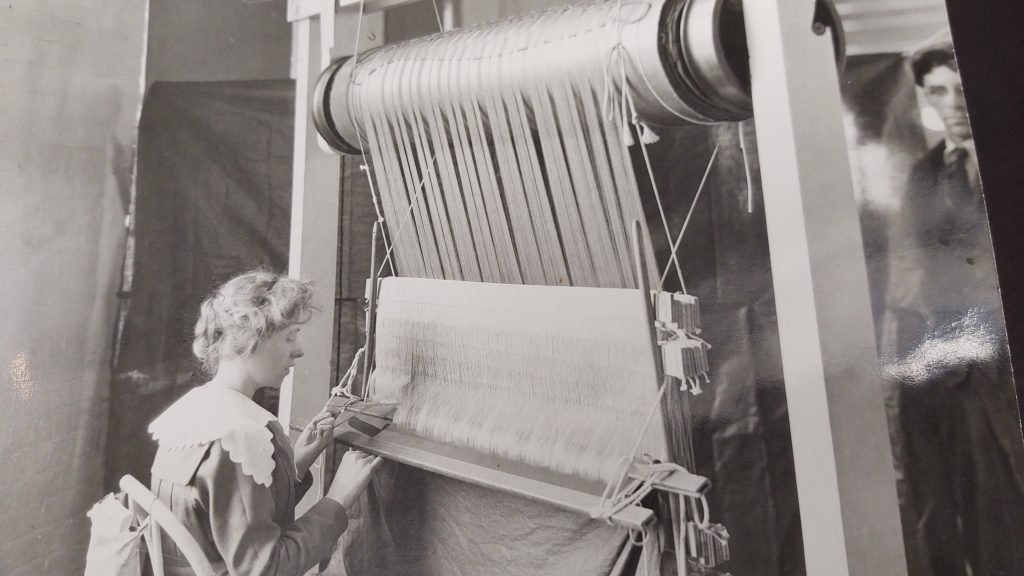
Photo Credit: Alvah Belding Library
While weaving Beatrice thought about Alvah Belding and his many acts of kindness he had shown to the ladies who worked for the ‘Belding Brothers and Company’ silk mills. Alvah had sent a wagon to pick the young women up at the boarding houses after an extremely heavy snowfall. He had been a firm believer in treating his workers well. Alvah oversaw the manufacturing of this profitable silk business.
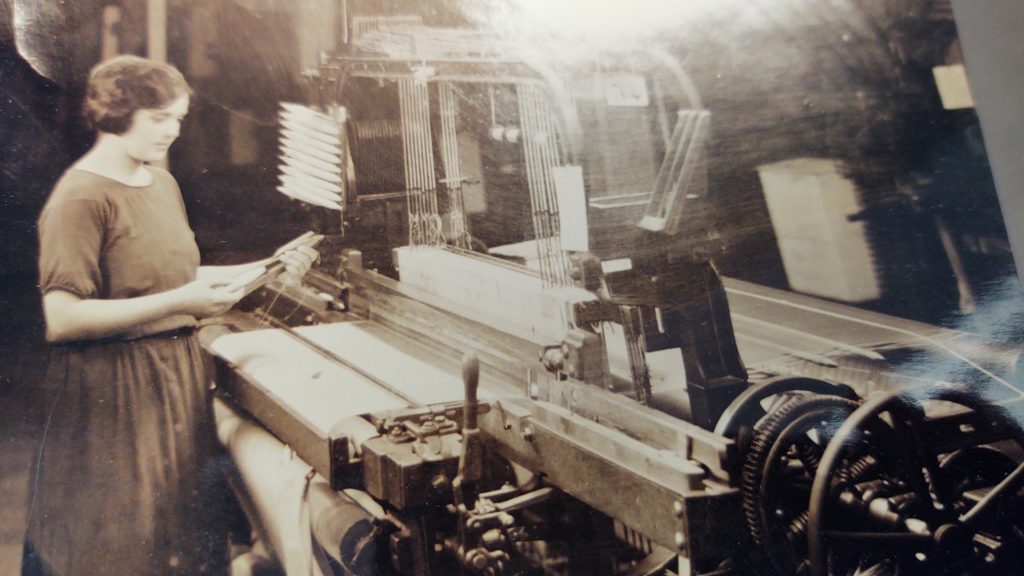
Ms. Slayton contemplated her good fortune. She was thankful to be able to make a living as a single woman in the early decade of this new century. Her weekly salary was a solid $8.00. With the boarding house only costing $2.50 each week, Beatrice was able to send some money home to her family, who lived less than 100 miles away. (‘Belding Brothers and Company’ recruited single women within a 100 mile radius. If a young lady could convince her friends to sign on as well, then her train fare would be covered by the company.)
The Boarding Houses
I was captivated by these women who stayed at the boarding houses, earning a living. What were their lives like? I searched for more photographs and stories. I was amazed that I hadn’t known this history of Belding, Michigan.
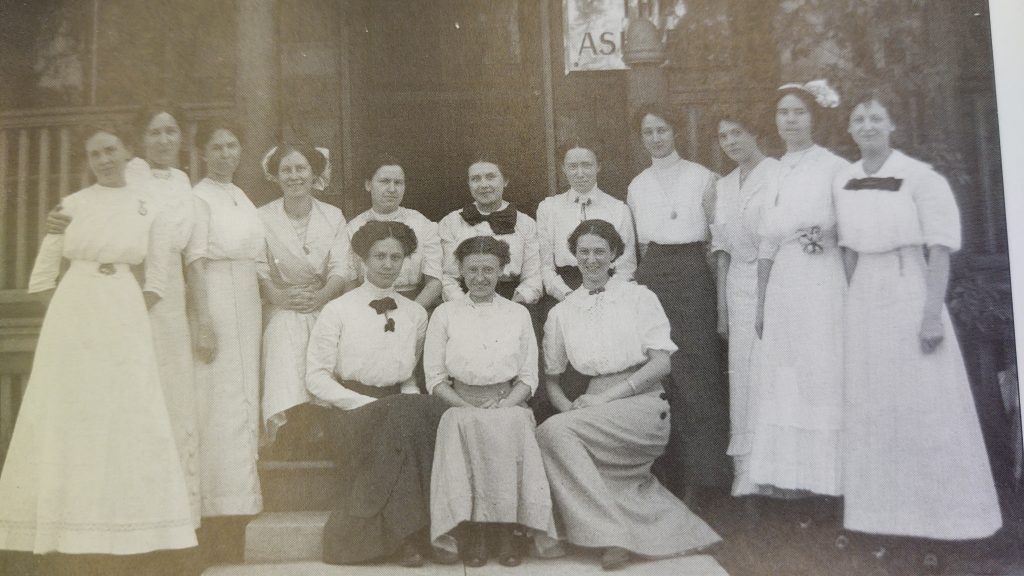
provided by The Belding Brothers and Company.
Photo Credit: “Images of America: Belding”
Keeping with the era’s expectations, the Ashfield, the White Swan and the Belrockton rooming houses held strict guidelines. The ladies needed to abide by the 9:30 pm curfew and lights were turned off by 10:00. These were comfortable dorms with hot and cold water, baths, electricity, steam heat and free libraries.
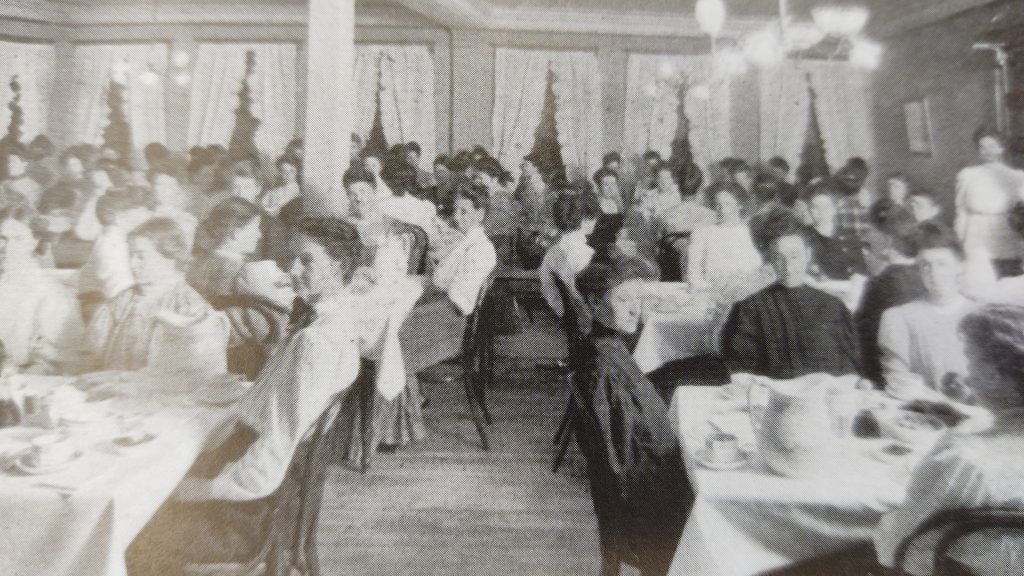
Photo Credit: Alvah Belding Library
Ashfield Boarding House

Photo Credit: Belding Public Museum
(Top) The only remnants left are the crumbling stairs which hold a long history.
They are located on the corner of Ashfield and Harrison.
The Belding brothers were firm believers in treating their workers well. After all, happy workers were more productive.
The Belrockton
Built in 1906 as a rooming house for female workers, The Belrockton now serves as the Belding Museum. It’s gorgeous!
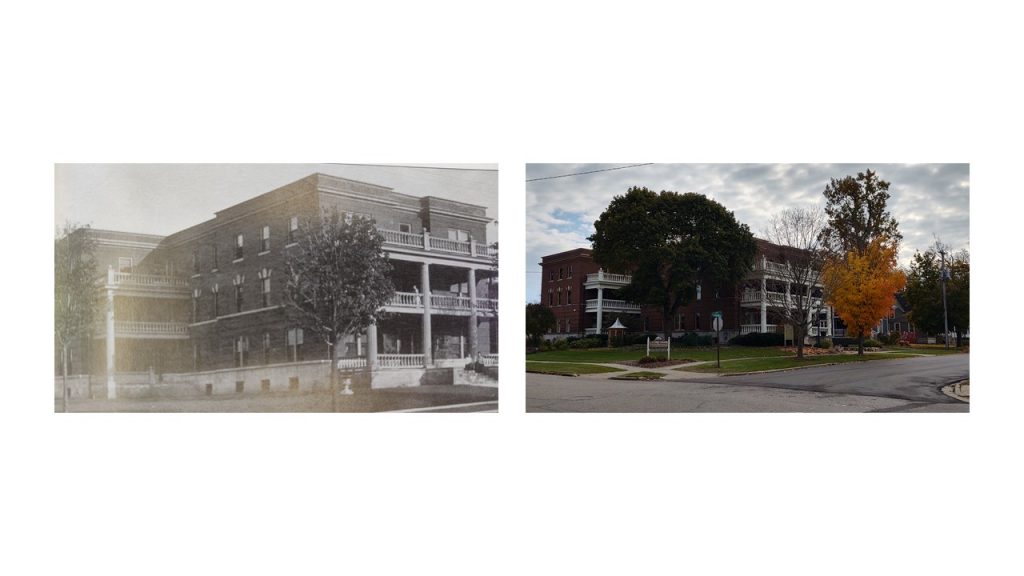
The Belrockton was named for the three Belding Brother Company locations:
Belding, MI, Rockville, MA and Northhampton, CT
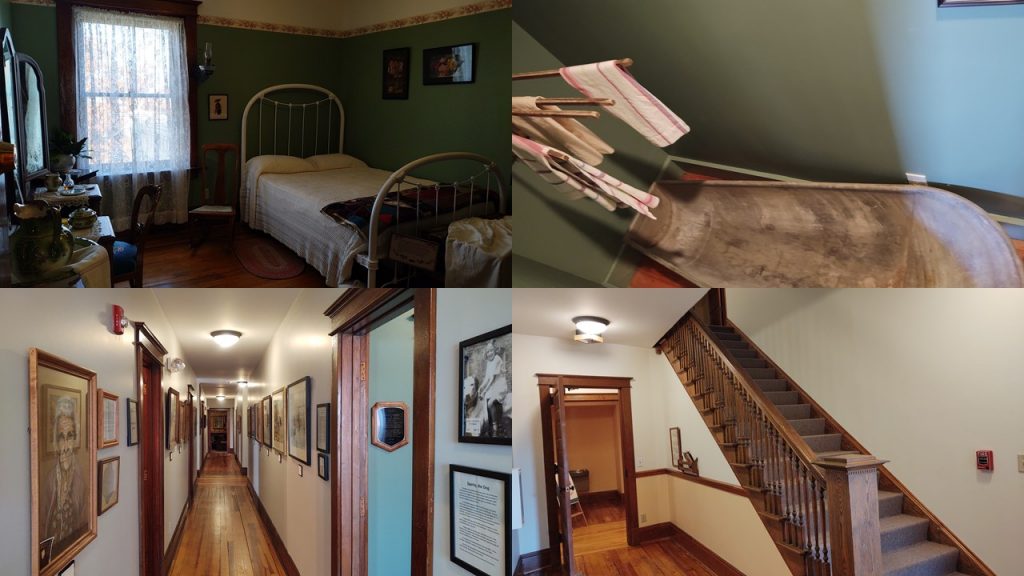
(Bedroom, Bathtub Closet, Hallway, Stairway)
In the museum each third floor room reveals a different era. A hands-on children’s museum covers the second floor.
The Belding Museum is open on the first Sunday of the month from 1:00 – 4:00 pm.
Suitors
With the large population of single females in the area, many young men traveled by train from Greenville and from Grand Rapids on Friday nights to attempt to catch the eye of a young lass. Men would come and sit on the fence railing, dangling their feet, acting innocent. There were plenty of activities around town, too!
Bands would play in the park on Sundays. Ice cream would be served at the pavilion. The Idlewilde Winnona Riverboat would entertain patrons as it traveled up and down the Flat River. The Belding Brothers and Company had built an opera house, as well, to entertain their workers.
There were “Toe Socials.” Women would reveal their toes from behind a sheet and men would bid for a date based on the teeny appendages shown.
Well, some of these independent women didn’t appreciate the attention, so a few had smeared molasses along the ledge of the boarding house. As the boys sat in the thick, sticky liquid, the ladies giggled from the windowsills.
Male Workers
Male workers at the Belding Brothers and Company silk mills made up the remaining 25% of the staff. They worked as warpers, dryers, loom fixers and superintendents. Most were married. The Belding Brothers and Company provided their male staff members with nearby homes to rent.
The Belding Brothers
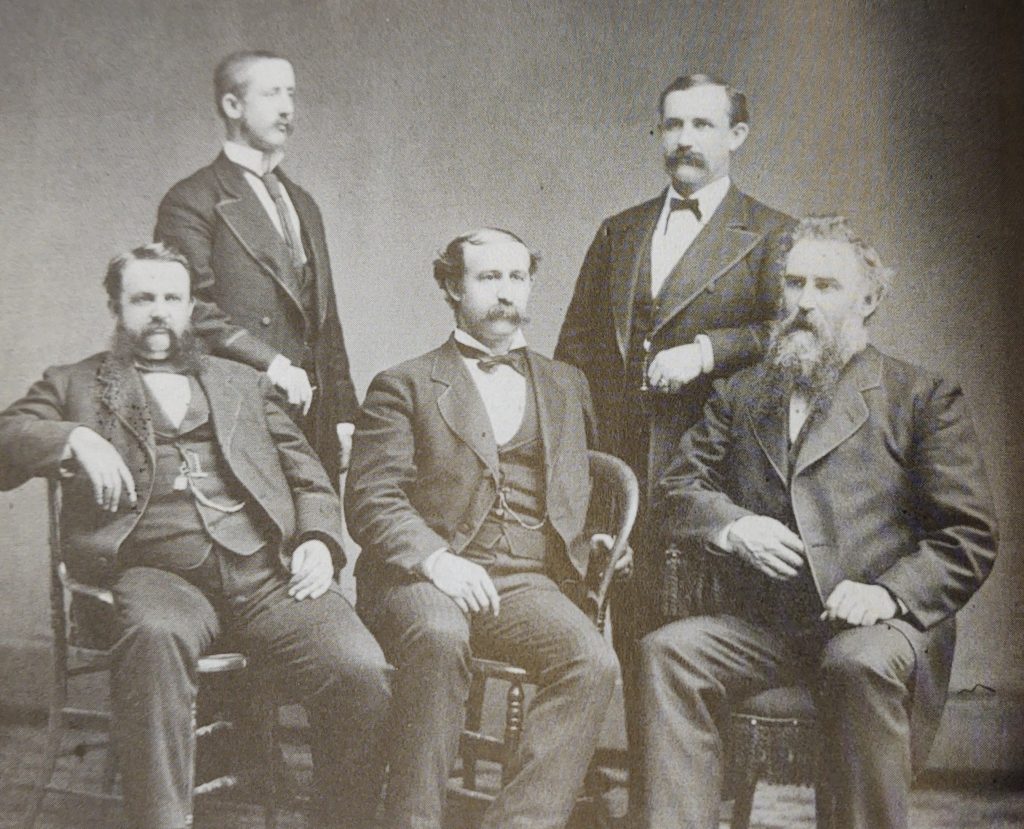
(Standing) Milo M. and Alvah, (seated L to R) Hiram H. Jr., David W., Hiram Sr.
Hiram H. Jr. lived in Belding only a short time and then moved to Chicago to oversee the family’s silk industry. Hiram Jr. sadly died at 55 years old. David was a teacher in southern Ohio. It was reported that Hiram Sr. wasn’t involved in the silk industry. Milo was the second oldest and was the first to sell silk thread door to door at the beginning of their vocation. Milo became the company’s president. Alvah was the youngest of the Belding clan. He headed the manufacturing. Alvah advocated for his workers and left a lasting impression, naming the city’s library in his honor.
After building a successful silk business in Rockville, CT. (1866), the Belding family expanded to a mill in Northhampton, MA where a variety of embroidery threads were manufactured. With demand increasing, they set roots in Michigan in 1890. The Belding Brothers left their mark and their name!
Unfortunately, with the introduction of synthetic thread, the mills were all closed down by 1932. However, the Belding name lives on and carries the city into the future.
The Red Mill #1
The Red Mill #1 was built in 1890 with an addition made in 1892. It’s primary purpose was for producing silk thread.
The White Mill #2
The White Mill known as #2 comprised of weaving. It was built in 1901 with a clock tower completed in 1903. (In 2013 the clock tower took 2 weeks to disassemble.)
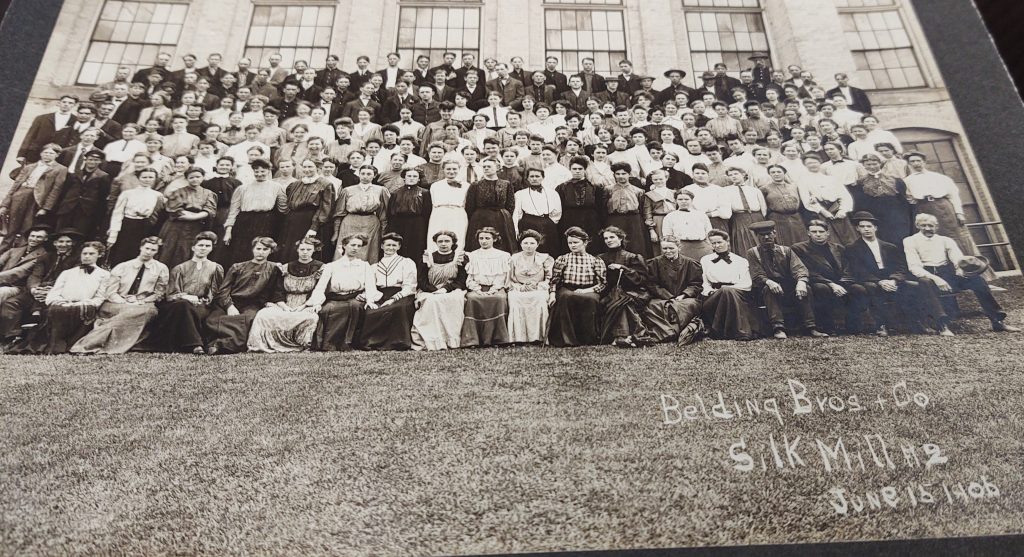
Photo Credit: Alvah Belding Library
As I held this photograph, hopeful faces peered back at me. All these lives held stories. I wish I could honor each by telling their tales.
Elise Cuuken
The sad story of Elise Cuuken has haunted the workers of Belding. Elise had asked to leave The White Mill a little early, so she could be sure to pick up flowers for a funeral. She needed to deliver the arrangement to the train, so it could be transported on time. Sadly, Ms. Cuuken was fatally struck by a falling brick from the clock tower as it was being built. The brick had simply slipped from a worker’s hand. Dismally, the floral arrangement was used at Elise Cuuken’s funeral.
The Richardson Mill #4
The first silk mill to be built was the Richardson Mill, known as #4, in 1886. At that time the Belding Brothers were unsure of their new expansion into Michigan and sold this mill to Richardson Silk. The Belding Brothers didn’t want their name tied to the Michigan silk industry until they were sure it would be a success. After having a profitable beginning, the Belding Brothers and Company re-purchased the mill in 1907. You will notice the two water towers purposefully placed to create enough hydro-pressure to serve the facility.
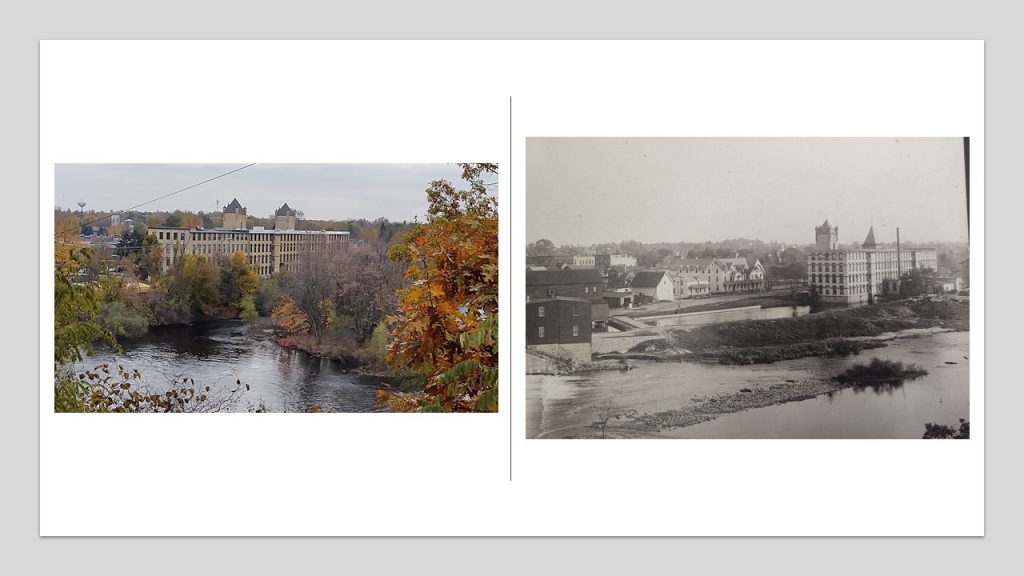
Photo Credits: Martha Hayden and Alvah Belding Library
Exactly one century later (1986) the Richardson Mill #4 was converted into apartments, “Flats On The River.” Keeping the a brick façade and large windows the residences holds the charm of the past. There are a variety of floor plans available for rent.
Summary
After sorting information at the Alvah N. Belding library, I felt hungry. The Silk City Saloon provided a delicious burger! I hadn’t realized the connection of the establishment’s name until that day.
I was shocked to learn that Belding had once supplied 90% of the United States silk supply. With four mills they processed over one million pounds of raw silk in the 1920’s. The four Belding brothers shaped this town with their fairness for their workers. They have left a lasting legacy. I enjoyed digging into the apparent hidden history of Belding, Michigan.
Related Links:
Restless Viking merchandise is now available!
Resources:
Alvah Belding Library Kelly retrieved vertical files for me with photos and notes about the Silk Industry in Belding. Check out Kelly’s blog: The Posh Librarian.
Images of America: Belding by Cindy M. Hughes



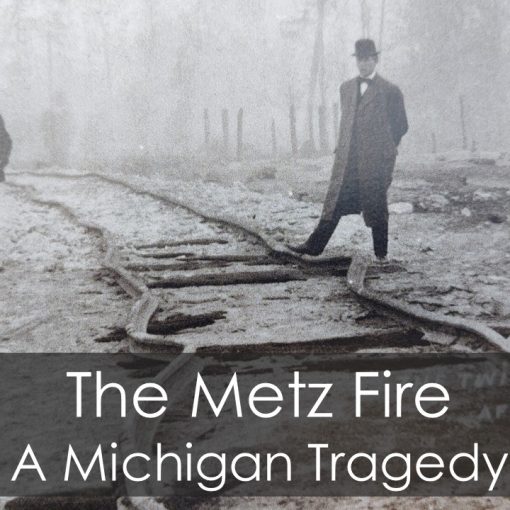

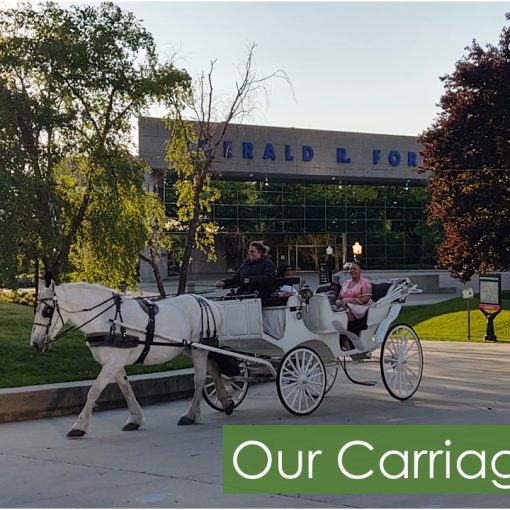
17 thoughts on “Belding’s Secret – Silk”
Fantastic insight into Belding’s silk industry. Very well researched and written. I have learned things about the silk mills history that I did not already know! Well done 🙂
Other notes: There was (maybe still is) a sports apparel store called Silk City Sports that did a lot of business in the 1990’s when we had a competitive football team. Most people in town likely still call the apartment building ‘Richardson Mills’ because it was only renamed in the past 10 years or so. The forth cool building in town – across the river from the library and a bit west- was once a basket factory, according to my dad.
I always wondered about those stairs on Ashfield/Harrison.
Beatrice Slayton was my great-grandmother, but Slayton was her married name. Her maiden name was Noble. I loved seeing her pictured in your story! I miss her dearly.
Lori,
This is a remarkable connection! Thanks for reaching out!
I miss her too Lori as you know, since I’m your mom, she was my Grandmother. 🙂 She enjoyed knitting her whole life.
Cool story… Awesome history saved thru time!!!!
Thank you for your feedback, Kyle. I have enjoyed learning more about Belding!
I was raised in Belding in the 50’s and 60’s. My first job (in the 9th grade) was as a page in the Alvah N. Belding Library. I returned recently after over 50 years away. The library and the Belrockton remain almost exactly as I left them. The library tables where I sat for hours using the encyclopedias to write papers are still the same. It’s a delightful slice out of time past. I really enjoyed your article!
The library is so beautiful with all the gorgeous wood, and it still smells the same—like old books and wood polish. I have such happy memories of Belding, her history, and the old silk mill buildings.
I adore your connection to Belding! Thank you for sharing!
Where did the silk come from?
Juliet, Thank you for reaching out with a question about Belding’s Silk Industry. I found that their brother, Milo Belding, had lived out east and sold the silk to the Michigan factories. “This silk was purchased for them by their brother, Milo M. Belding, who was then residing at their common birth-place, Ashfield, MA.” Thank you for inquiring about Belding’s silk! -Martha
I’m originally from Fort Wayne and I’ve known about the factory for years. My aunt lived in Belding on a hill overlooking it. My cousin and I would would walk down the hill and just hang out. On July 4th, the fireworks would echo around the building and the river. (This was in the early-mid 70’s)
My grandmother worked there sometime between 1900 and 1910. She met my grandfather, from Grand Rapids, and they were married there and my father was born there. I have a group picture with my grandmother and other women in her boarding house perhaps. Thank you so much for your research. I never knew her story until I got the picture today and wanted to know her story!
“Thirty girls of the Belding Bros. & Co. Mills went out on a strike demanding 10% increase in their wages. A few days after they returned to work without their demands being granted p. 244 Michigan Dept. of Labor. May 1, 1901.
Michael,
I hadn’t realized that there had been a strike! Thank you for sharing your insight along with the reference.
Martha
Hello, I have recently acquired a sweet handmade girls silk pleated skirt (and small fabric remnant bearing “Belding’s Yardwide” on the selvage). I am curious to learn if there is some way to age the fabric. I suppose the skirt could have been made anytime.
Elizabeth,
I wish I had expertise, but alas I don’t. Possibly the Belding Museum historians could help. Their phone number is 616-794-1900. Located at 108 Hanover Street in the Belrockton dormitory. it is open on the first Sunday of the month from 11:00 am – 5:00 pm. The City of Belding may offer a contact, too. 616-794-1900. Thank you for taking time to reach out to us!
Poppins